JEEP CJ 1953 Service Manual
Manufacturer: JEEP, Model Year: 1953, Model line: CJ, Model: JEEP CJ 1953Pages: 376, PDF Size: 19.96 MB
Page 181 of 376
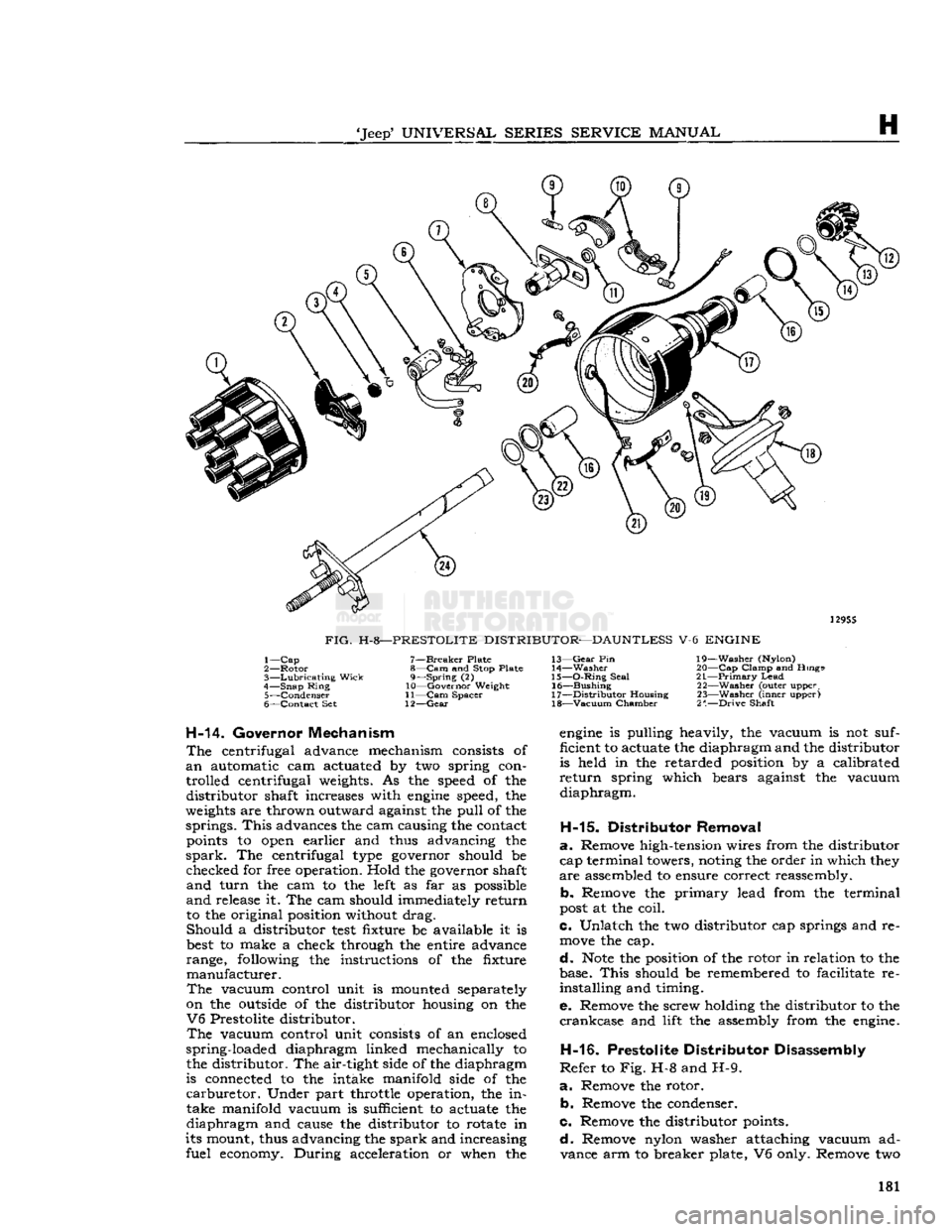
'Jeep'
UNIVERSAL
SERIES SERVICE
MANUAL
H
12955
FIG.
H-8—PRESTOLITE
DISTRIBUTOR—DAUNTLESS V-6 ENGINE 1—
Cap
2—
Rotor
3—
Lubricating
Wick
4—
Snap
Ring
5—
Condenser
6—
Contact
Set 7—
Breaker
Plate
8—
Cam
and Stop Plate 9—
Spring
(2)
10—
Governor
Weight
11— Cam
Spacer
12—
Gear
13—
Gear
Pin
14—
Washer
15—
O-Ring
Seal
16—
Bushing
17—
Distributor
Housing 18—
Vacuum
Chamber
19—
Washer
(Nylon)
20—
—Cap
Clamp
and Rings
21—
—Primary
Lead
22—
Washer
(outer upper,
23—
Washer
(inner upper)
2".—Drive
Shaft
H-14. Governor Mechanism
The
centrifugal advance mechanism consists of
an
automatic cam actuated by two spring con
trolled centrifugal weights. As the
speed
of the distributor shaft increases with
engine
speed, the
weights
are thrown outward against the pull of the springs.
This
advances the cam causing the contact
points
to
open
earlier and thus advancing the
spark.
The centrifugal
type
governor should be checked for free operation. Hold the governor shaft
and
turn the cam to the
left
as far as possible
and
release it. The cam should immediately return to the original position without drag. Should a distributor
test
fixture be available it is
best
to make a check through the entire advance
range, following the instructions of the fixture manufacturer.
The
vacuum control unit is mounted separately
on the
outside
of the distributor housing on the
V6
Prestolite distributor.
The
vacuum control unit consists of an enclosed
spring-loaded diaphragm linked mechanically to the distributor. The air-tight side of the diaphragm
is connected to the intake manifold side of the
carburetor.
Under part throttle operation, the intake manifold vacuum is sufficient to actuate the
diaphragm and cause the distributor to rotate in
its mount, thus advancing the spark and increasing fuel
economy.
During acceleration or when the
engine
is pulling heavily, the vacuum is not suf
ficient to actuate the diaphragm and the distributor
is held in the retarded position by a calibrated
return
spring which bears against the vacuum
diaphragm.
H-15.
Distributor Removal
a.
Remove high-tension wires from the distributor cap terminal towers, noting the order in which
they
are
assembled to ensure correct reassembly.
b. Remove the primary lead from the terminal
post
at the coil.
c. Unlatch the two distributor cap springs and re
move
the cap.
d.
Note
the position of the rotor in relation to the
base.
This
should be remembered to facilitate re installing and timing.
e. Remove the screw holding the distributor to the
crankcase
and lift the assembly from the
engine.
H-16.
Prestolite Distributor Disassembly
Refer
to Fig. H-8 and H-9.
a.
Remove the rotor. b. Remove the condenser.
c. Remove the distributor points.
d.
Remove nylon washer attaching vacuum advance arm to breaker plate, V6 only. Remove two 181
Page 182 of 376
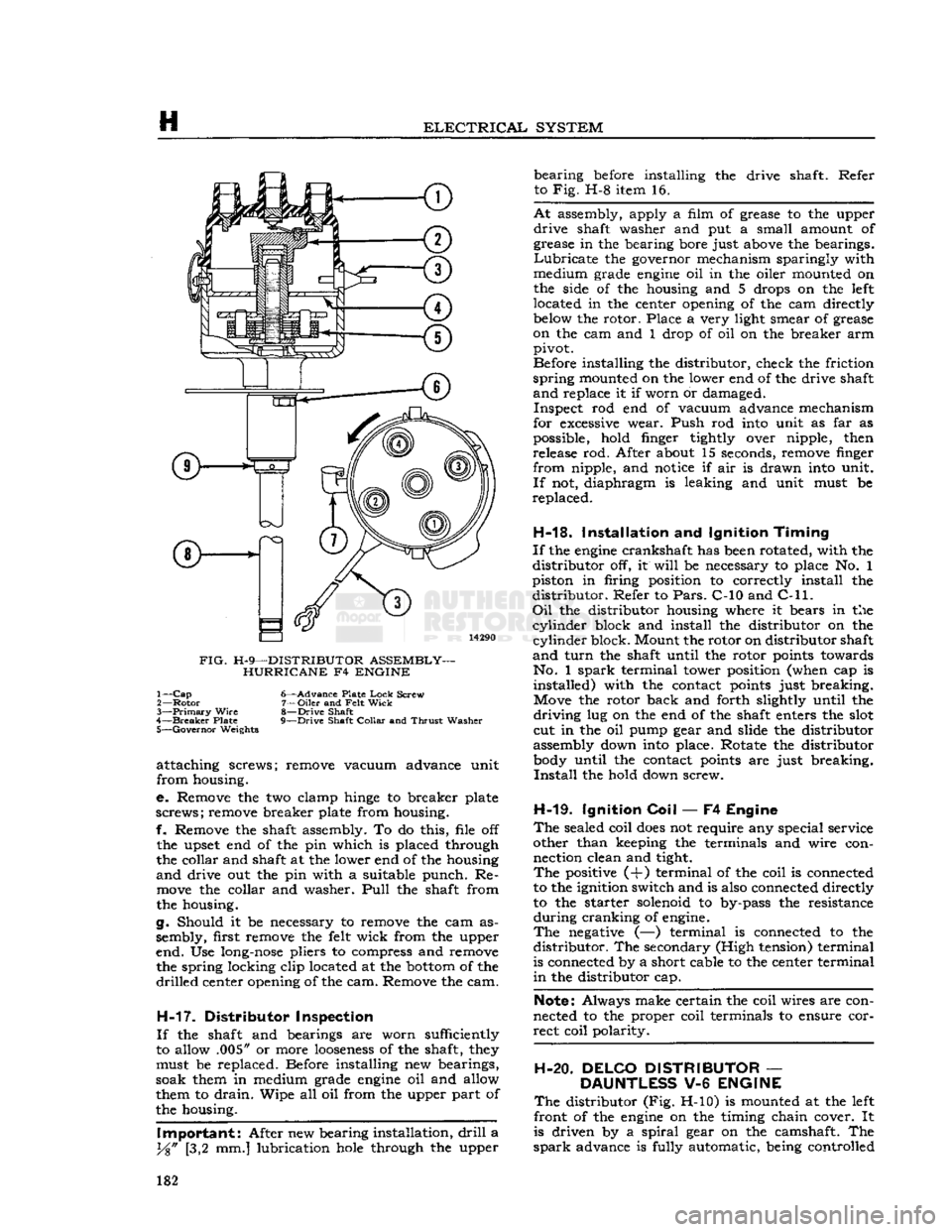
H
ELECTRICAL
SYSTEM
FIG.
H-9—DISTRIBUTOR ASSEMBLY- HURRICANE F4 ENGINE 1—
Cap
6—Advance Plate
Lock
Screw
2—
Rotor
7—Oiler and
Felt
Wick
3—
Primary
Wire
8—Drive Shaft
4—
Breaker
Plate 9—Drive Shaft
Collar
and
Thrust
Washer 5—
Governor
Weights
attaching screws; remove vacuum advance unit
from housing.
e. Remove the two clamp
hinge
to breaker plate
screws; remove breaker plate from housing.
f. Remove the shaft assembly. To do this, file off
the upset end of the pin which is placed through
the collar and shaft at the lower end of the housing
and
drive out the pin with a suitable punch. Re
move
the collar and washer.
Pull
the shaft from
the housing.
g. Should it be necessary to remove the cam as
sembly, first remove the
felt
wick from the upper
end. Use
long-nose
pliers to compress and remove the spring locking clip located at the
bottom
of the
drilled
center opening of the cam. Remove the cam.
H-17.
Distributor Inspection
If
the shaft and bearings are worn sufficiently
to allow .005" or more
looseness
of the shaft,
they
must be replaced. Before installing new bearings,
soak them in medium grade
engine
oil and allow
them to
drain.
Wipe all oil from the upper part of
the housing.
Important:
After new bearing installation,
drill
a
y%"
[3,2 mm.] lubrication
hole
through the upper bearing
before
installing the drive shaft. Refer
to Fig. H-8 item 16.
At
assembly, apply a film of grease to the upper
drive
shaft washer and put a small amount of
grease in the bearing bore just
above
the bearings.
Lubricate
the governor mechanism sparingly with
medium grade
engine
oil in the oiler mounted on
the side of the housing and 5 drops on the
left
located in the center opening of the cam directly
below
the rotor. Place a very light smear of grease
on the cam and 1 drop of oil on the breaker arm pivot.
Before installing the distributor, check the friction
spring
mounted on the lower end of the drive shaft
and
replace it if worn or damaged. Inspect rod end of vacuum advance mechanism
for
excessive
wear. Push rod
into
unit as far as
possible, hold finger tightly over nipple, then release rod. After about 15 seconds, remove finger
from nipple, and
notice
if air is drawn
into
unit.
If
not, diaphragm is leaking and unit must be
replaced.
H-18.
Installation and Ignition
Timing
If
the
engine
crankshaft has
been
rotated, with the
distributor off, it
will
be necessary to place No. 1
piston in firing position to correctly install the distributor. Refer to
Pars.
C-10 and
C-ll. Oil
the distributor housing where it bears in the
cylinder
block and install the distributor on the
cylinder
block. Mount the rotor on distributor shaft
and
turn
the shaft until the rotor
points
towards No. 1
spark
terminal tower position (when cap is installed) with the contact
points
just breaking. Move the rotor back and forth slightly until the
driving
lug on the end of the shaft enters the
slot
cut in the oil pump gear and slide the distributor
assembly down
into
place. Rotate the distributor
body
until the contact
points
are just breaking.
Install
the hold down screw.
H-19.
Ignition
Coil
— F4 Engine
The
sealed coil
does
not require any special service
other than keeping the terminals and wire con nection clean and tight.
The
positive (+) terminal of the coil is connected
to the ignition switch and is also connected directly
to the starter solenoid to by-pass the resistance
during
cranking of
engine.
The
negative
(—) terminal is connected to the
distributor. The secondary (High tension) terminal
is connected by a short cable to the center terminal
in
the distributor cap.
Note:
Always make certain the coil wires are con
nected to the proper coil terminals to ensure cor
rect coil polarity.
H-20. DELCO DISTRIBUTOR
—
DAUNTLESS
V-6
ENGINE
The
distributor (Fig. H-10) is mounted at the
left
front of the
engine
on the timing chain cover. It
is driven by a
spiral
gear on the camshaft. The
spark
advance is fully automatic, being controlled 182
Page 183 of 376
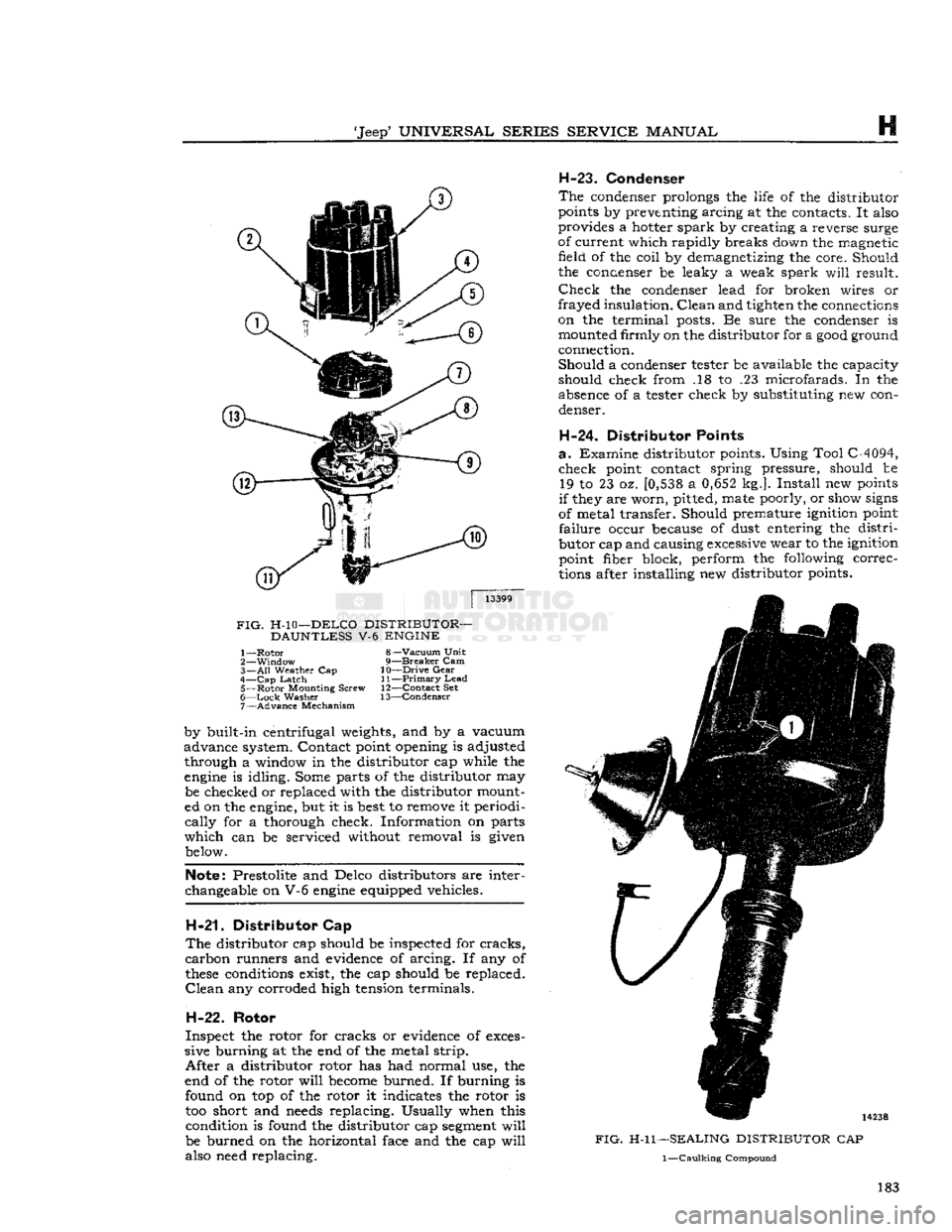
'Jeep*
UNIVERSAL
SERIES SERVICE
MANUAL
H
|
13399
FIG.
H-10—DELCO
DISTRIBUTOR—
DAUNTLESS
V-6
ENGINE
1—
Rotor
8—Vacuum
Unit
2—
Window
9—Breaker Cam
3—
All
Weather Cap
10—Drive
Gear
4—
Cap
Latch
11—Primary Lead 5—
Rotor
Mounting
Screw 12—Contact Set
6—
Lock
Washer 13—Condenser
7—
Advance
Mechanism
by
built-in
centrifugal weights, and by a vacuum
advance
system. Contact point opening is adjusted
through
a window in the distributor cap
while
the engine is
idling.
Some
parts
of the distributor may be checked or replaced
with
the distributor mount
ed on the engine, but it is
best
to remove it periodi
cally
for a thorough check. Information on
parts
which
can be serviced without removal is given
below.
Note:
Prestolite and Delco distributors are inter
changeable
on V-6 engine equipped vehicles.
H-21.
Distributor Cap
The distributor cap should be inspected for cracks,
carbon runners and evidence of arcing. If any of
these
conditions exist, the cap should be replaced. Clean any corroded high tension terminals.
H-22.
Rotor
Inspect the rotor for cracks or evidence of
exces
sive burning at the end of the metal strip.
After
a distributor rotor has had normal use, the
end of the rotor
will
become
burned. If burning is
found
on top of the rotor it indicates the rotor is too short and
needs
replacing. Usually when this
condition
is found the distributor cap
segment
will
be burned on the horizontal face and the cap
will
also
need
replacing.
H-23.
Condenser
The
condenser
prolongs the
life
of the distributor
points by preventing arcing at the contacts. It
also
provides a hotter spark by creating a
reverse
surge
of
current
which
rapidly
breaks
down the magnetic
field
of the
coil
by demagnetizing the core. Should
the
ccnaenser
be leaky a weak spark
will
result. Check the
condenser
lead for broken wires or
frayed
insulation.
Clean and tighten the connections
on
the terminal
posts.
Be
sure
the
condenser
is mounted
firmly
on the distributor for a good ground
connection.
Should
a
condenser
tester
be available the capacity
should check
from
.18 to .23 microfarads. In the
absence
of a
tester
check by substituting new con
denser.
H-24. Distributor Points
a-
Examine distributor points. Using
Tool
C-4094, check point contact spring
pressure,
should be 19 to 23 oz. [0,538 a 0,652 kg.]. Install new points
if
they are
worn,
pitted,
mate
poorly, or show
signs
of
metal transfer. Should premature
ignition
point
failure
occur
because
of dust entering the
distri
butor cap and causing
excessive
wear to the
ignition
point
fiber block, perform the
following
correc
tions after installing new distributor points.
FIG. H-l
1—SEALING
DISTRIBUTOR
CAP
1—Caulking
Compound
183
Page 184 of 376
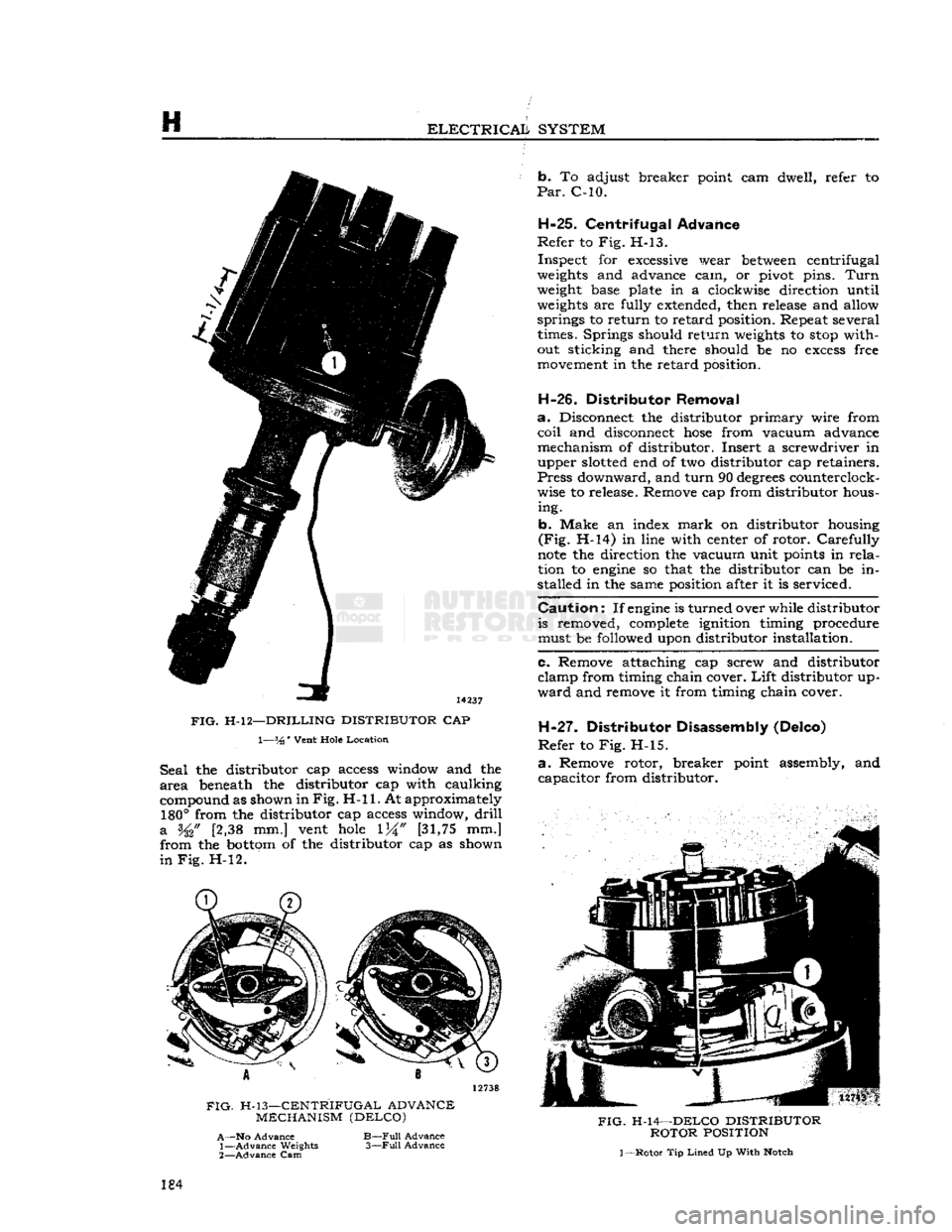
H
ELECTRICAL
SYSTEM
14237
FIG.
H-l2—DRILLING DISTRIBUTOR
CAP 1—%'
Vent
Hole
Location
Seal
the distributor cap access window and the
area
beneath the distributor cap with caulking
compound as shown in
Fig. H-ll.
At approximately
180°
from the distributor cap access window,
drill
a
[2,38 mm.] vent
hole
[31,75
mm.]
from the
bottom
of the distributor cap as shown
in
Fig. H-l2. b. To adjust breaker point cam dwell, refer to
Par.
C-10.
H-25.
Centrifugal Advance
Refer
to Fig. H-13.
Inspect for
excessive
wear
between
centrifugal
weights
and advance cam, or pivot pins.
Turn
weight
base plate in a clockwise direction until
weights
are fully extended, then release and allow springs to return to retard position. Repeat several times. Springs should return
weights
to
stop
without sticking and there should be no
excess
free
movement
in the retard position.
H-26.
Distributor Removal
a.
Disconnect the distributor primary wire from
coil
and disconnect
hose
from vacuum advance
mechanism of distributor. Insert a screwdriver in upper
slotted
end of two distributor cap retainers.
Press
downward, and turn 90
degrees
counterclock
wise to release. Remove cap from distributor hous ing.
b. Make an index
mark
on distributor housing
(Fig.
H-14) in line with center of rotor. Carefully
note
the direction the vacuum unit
points
in
rela
tion to
engine
so that the distributor can be in
stalled in the same position after it is serviced.
Caution:
If
engine
is turned over while distributor is removed,
complete
ignition timing procedure
must be followed upon distributor installation.
c. Remove attaching cap screw and distributor
clamp from timing chain cover.
Lift
distributor up
ward
and remove it from timing chain cover.
H-27.
Distributor Disassembly (Delco)
Refer
to Fig. H-l5.
a.
Remove rotor, breaker point assembly, and capacitor from distributor.
FIG.
H-13—CENTRIFUGAL ADVANCE
MECHANISM (DELCO)
A—No
Advance
1—
Advance
Weights
2—
Advance
Cam
B—Full
Advance
3—Full
Advance
FIG.
H-14—DELCO DISTRIBUTOR
ROTOR
POSITION
1
—Rotor
Tip
Lined
Up
With
Notch
184
Page 185 of 376
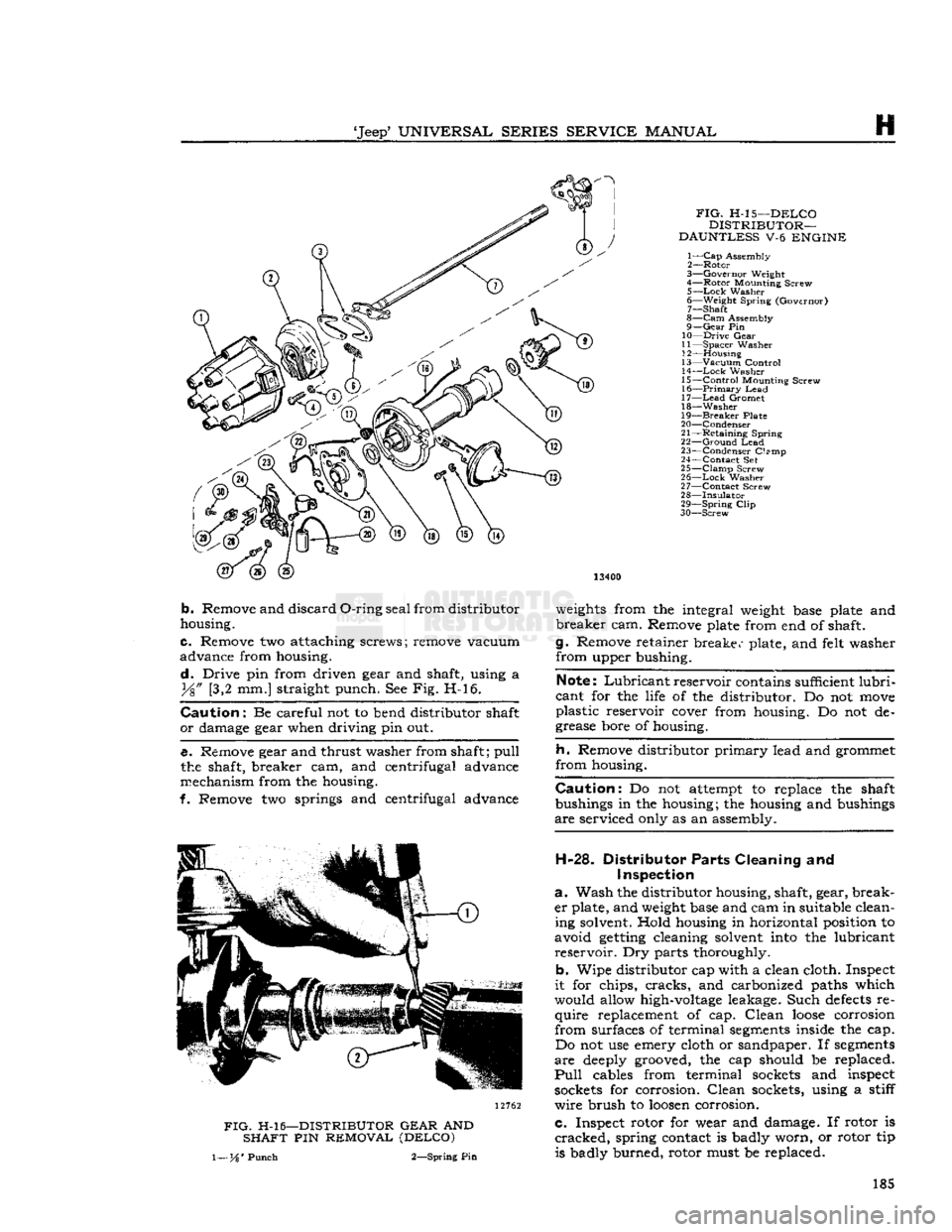
'Jeep*
UNIVERSAL
SERIES SERVICE
MANUAL
H
FIG.
H-l 5 -DELCO
DISTRIBUTOR—
DAUNTLESS V-6 ENGINE
1—
Cap Assembly
2— Rotor
3— Governor Weight
4— Rotor
Mounting
Screw 5—
Lock
Washer
6—
Weight
Spring (Governor) 7— Shaft
8— Cam Assembly
9—
Gear
Pin
10—
Drive
Gear
11—
Spacer
Washer
12—
Housing
13—
Vacuum
Control
14—
Lock
Washer
15—
Control
Mounting
Screw
16—
Primary
Lead
17— Lead Gromet
18— Washer
19—
Breaker
Plate
20—
Condenser
21—
Retaining
Spring
22—
Ground
Lead
23—
Condenser
Clsmp
24— Contact Set
25— Clamp Screw
26—
Lock
Washer
27— Contact Screw
28—
Insulator 29—
Spring
Clip
30—
Screw 13400
b.
Remove and discard
O-ring
seal from distributor
housing.
c. Remove two attaching screws; remove vacuum
advance from housing.
d.
Drive pin from driven gear and shaft, using a
y%"
[3,2 mm.] straight punch. See Fig. H-l6.
Caution:
Be careful not to bend distributor shaft
or damage gear when driving pin out.
e.
Remove gear and thrust washer from shaft; pull the shaft, breaker cam, and centrifugal advance
mechanism from the housing.
f. Remove two springs and centrifugal advance
weights
from the integral
weight
base plate and
breaker
cam. Remove plate from end of shaft.
g. Remove retainer breaker plate, and
felt
washer from upper bushing.
Note:
Lubricant
reservoir contains sufficient
lubri
cant for the life of the distributor. Do not
move
plastic reservoir cover from housing. Do not de-
grease bore of housing.
h. Remove distributor primary lead and grommet
from housing.
Caution:
Do not attempt to replace the shaft
bushings in the housing; the housing and bushings
are
serviced only as an assembly.
FIG.
H-l6—DISTRIBUTOR GEAR AND
SHAFT PIN REMOVAL (DELCO) 1— H' Punch
2—Spring
Pin
H-28.
Distributor Parts
Cleaning
and
Inspection
a.
Wash the distributor housing, shaft, gear, break
er
plate, and
weight
base and cam in suitable clean ing solvent. Hold housing in horizontal position to
avoid
getting
cleaning solvent
into
the lubricant
reservoir.
Dry parts thoroughly.
b.
Wipe distributor cap with a clean cloth. Inspect
it for chips,
cracks,
and carbonized paths which
would allow
high-voltage
leakage. Such
defects
re
quire
replacement of cap.
Clean
loose
corrosion
from surfaces of terminal
segments
inside the cap. Do not use emery cloth or sandpaper. If
segments
are
deeply
grooved, the cap should be replaced.
Pull
cables from terminal
sockets
and inspect
sockets
for corrosion.
Clean
sockets, using a stiff
wire
brush to
loosen
corrosion.
c.
Inspect rotor for wear and damage. If rotor is
cracked,
spring contact is badly worn, or rotor tip is badly burned, rotor must be replaced. 185
Page 186 of 376
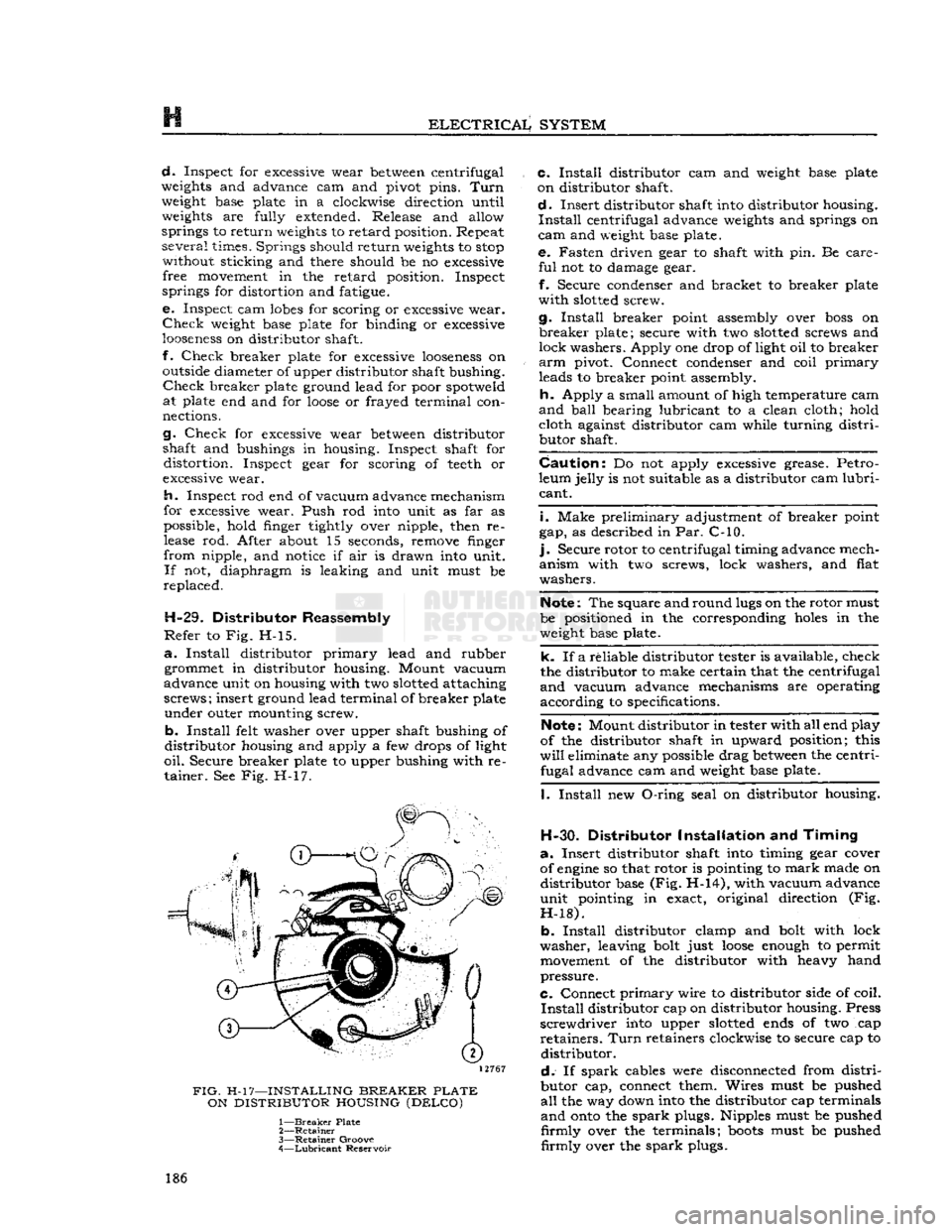
ELECTRICALJ
SYSTEM
d.
Inspect for
excessive
wear
between
centrifugal
weights
and advance cam and pivot pins.
Turn
weight
base plate in a clockwise direction until
weights
are fully extended. Release and allow
springs to return
weights
to
retard
position. Repeat several times. Springs should return
weights
to
stop
without sticking and there should be no
excessive
free
movement
in the
retard
position. Inspect
springs for distortion and fatigue.
e. Inspect cam
lobes
for scoring or
excessive
wear.
Check
weight
base plate for binding or
excessive
looseness
on distributor shaft.
f.
Check
breaker plate for
excessive
looseness
on
outside
diameter of upper distributor shaft bushing.
Check
breaker plate ground lead for poor
spot
we
Id
at plate end and for
loose
or frayed terminal con
nections.
g.
Check
for
excessive
wear
between
distributor
shaft and bushings in housing. Inspect shaft for distortion. Inspect gear for scoring of
teeth
or
excessive
wear.
h.
Inspect rod end of vacuum advance mechanism
for
excessive
wear. Push rod
into
unit as far as
possible, hold finger tightly over nipple, then re
lease
rod. After about 15 seconds, remove finger
from nipple, and
notice
if air is drawn
into
unit.
If
not, diaphragm is leaking and unit must be
replaced.
H-29.
Distributor Reassembly
Refer
to Fig. H-l5.
a.
Install
distributor
primary
lead and rubber grommet in distributor housing. Mount vacuum
advance unit on housing with two
slotted
attaching
screws; insert ground lead terminal of breaker plate under outer mounting screw.
b.
Install
felt
washer over upper shaft bushing of
distributor housing and apply a few drops of light
oil.
Secure breaker plate to upper bushing with re tainer. See Fig. H-17.
12767
FIG.
H-17—INSTALLING
BREAKER
PLATE
ON
DISTRIBUTOR
HOUSING
(DELCO)
1—
Breaker
Plate
2—
Retainer
3—
Retainer
Groove
4—
Lubricant
Reservoir c.
Install
distributor cam and
weight
base plate
on distributor shaft.
d.
Insert distributor shaft
into
distributor housing.
Install
centrifugal advance
weights
and springs on
cam
and
weight
base plate. e. Fasten driven gear to shaft with pin. Be care
ful
not to damage gear.
f.
Secure condenser and bracket to breaker plate
with
slotted
screw.
g.
Install
breaker point assembly over
boss
on
breaker
plate; secure with two
slotted
screws and
lock washers. Apply one drop of light oil to breaker
arm
pivot. Connect condenser and coil
primary
leads to breaker point assembly.
h.
Apply a small amount of high temperature cam
and
ball
bearing lubricant to a clean cloth; hold cloth against distributor cam while turning
distri
butor shaft.
Caution:
Do not apply
excessive
grease. Petro
leum jelly is not suitable as a distributor cam
lubri
cant.
i.
Make preliminary adjustment of breaker point
gap, as described in Par. C-10.
].
Secure rotor to centrifugal timing advance mech
anism with two screws, lock washers, and flat
washers.
Note:
The square and round
lugs
on the rotor must
be positioned in the corresponding
holes
in the
weight
base plate.
k. If a reliable distributor tester is available, check
the distributor to make certain that the centrifugal
and
vacuum advance mechanisms are operating
according to specifications.
Note:
Mount distributor in tester with all end play
of the distributor shaft in upward position; this
will
eliminate any possible drag
between
the centri fugal advance cam and
weight
base plate.
I.
Install
new
O-ring
seal on distributor housing.
H-30.
Distributor
Installation
and
Timing
a.
Insert distributor shaft
into
timing gear cover
of
engine
so that rotor is pointing to
mark
made on distributor base (Fig. H-14), with vacuum advance
unit pointing in exact, original direction (Fig.
H-18).
b.
Install
distributor clamp and
bolt
with lock
washer, leaving
bolt
just
loose
enough
to permit
movement
of the distributor with heavy hand
pressure.
C.
Connect
primary
wire to distributor side of coil.
Install
distributor cap on distributor housing. Press
screwdriver
into
upper
slotted
ends
of two cap
retainers.
Turn
retainers clockwise to secure cap to distributor.
d.
If
spark
cables were disconnected from
distri
butor cap, connect them. Wires must be pushed
all
the way down
into
the distributor cap terminals
and
onto
the
spark
plugs. Nipples must be pushed
firmly
over the terminals;
boots
must be pushed
firmly
over the
spark
plugs. 186
Page 187 of 376
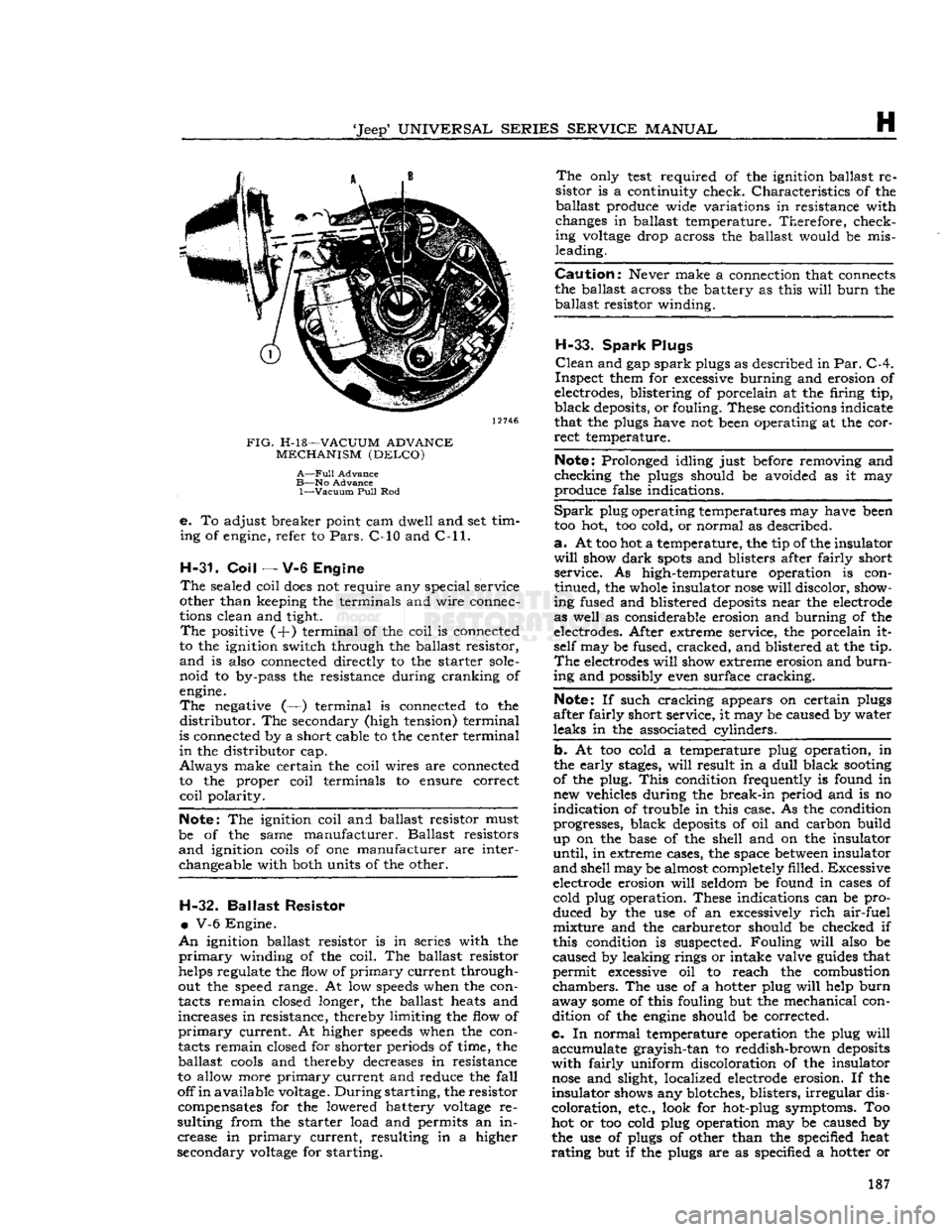
'Jeep'
UNIVERSAL
SERIES SERVICE
MANUAL
H
12746
FIG.
H-l8—VACUUM
ADVANCE
MECHANISM
(DELCO)
A—Full
Advance
B—No
Advance
1—Vacuum
Pull
Rod
e.
To adjust breaker point cam dwell and set tim
ing of engine, refer to
Pars.
C-10 and
C-ll.
H-31. Coil
— V-6 Engine
The
sealed coil
does
not require any special service
other than keeping the terminals and wire connec
tions clean and tight.
The
positive (+) terminal of the coil is connected
to the ignition switch through the ballast resistor,
and
is also connected directly to the starter
sole
noid to by-pass the resistance during cranking of
engine.
The
negative (—) terminal is connected to the
distributor.
The secondary (high tension) terminal
is connected by a short cable to the center terminal
in
the distributor cap.
Always
make certain the coil wires are connected to the proper coil terminals to ensure correct
coil
polarity.
Note:
The ignition coil and ballast resistor must
be of the same manufacturer. Ballast resistors
and
ignition coils of one manufacturer are interchangeable with both units of the other. H-32.
Ballast
Resistor
•
V-6 Engine.
An
ignition ballast resistor is in series with the
primary
winding of the coil. The ballast resistor
helps regulate the flow of
primary
current through
out the speed range. At low
speeds
when the con
tacts remain closed longer, the ballast heats and
increases in resistance, thereby limiting the flow of
primary
current. At higher
speeds
when the con
tacts remain closed for shorter periods of time, the ballast
cools
and thereby decreases in resistance
to allow more
primary
current and reduce the
fall
off
in
available voltage.
During
starting, the resistor compensates for the lowered battery
voltage
re
sulting from the starter load and permits an in crease in
primary
current, resulting in a higher
secondary
voltage
for starting.
The
only
test
required of the ignition ballast re
sistor is a continuity check. Characteristics of the ballast produce wide variations in resistance with
changes in ballast temperature. Therefore, check ing
voltage
drop across the ballast would be mis
leading.
Caution:
Never make a connection that connects
the ballast across the battery as this
will
burn
the ballast resistor winding.
H-33.
Spark
Plugs
Clean
and gap
spark
plugs as described in
Par.
C-4.
Inspect them for excessive burning and erosion of
electrodes, blistering of porcelain at the firing tip,
black
deposits, or fouling. These conditions indicate
that the plugs have not been operating at the cor
rect
temperature.
Note:
Prolonged idling just before removing and
checking the plugs should be avoided as it may
produce false indications.
Spark
plug operating temperatures may have been
too hot, too cold, or normal as described.
a.
At too hot a temperature, the tip of the insulator
will
show
dark
spots
and blisters after fairly short service. As high-temperature operation is con
tinued, the whole insulator
nose
will
discolor, show
ing fused and blistered
deposits
near the electrode
as well as considerable erosion and burning of the
electrodes. After extreme service, the porcelain it self may be fused, cracked, and blistered at the tip.
The
electrodes
will
show extreme erosion and
burn
ing and possibly even surface cracking.
Note:
If such cracking appears on certain plugs
after fairly short service, it may be caused by water
leaks in the associated cylinders.
b. At too cold a temperature plug operation, in
the early
stages,
will
result in a
dull
black
sooting
of the plug.
This
condition frequently is found in new vehicles during the break-in period and is no
indication of trouble in this case. As the condition progresses, black
deposits
of oil and carbon build
up on the base of the shell and on the insulator
until,
in extreme cases, the space
between
insulator
and
shell may be almost completely filled. Excessive
electrode erosion
will
seldom be found in cases of cold plug operation. These indications can be pro
duced by the use of an excessively
rich
air-fuel mixture and the carburetor should be checked if
this condition is suspected. Fouling
will
also be
caused by leaking rings or intake valve
guides
that
permit excessive oil to reach the combustion
chambers.
The use of a hotter plug
will
help
burn
away
some
of this fouling but the mechanical con dition of the
engine
should be corrected.
c. In normal temperature operation the plug
will
accumulate grayish-tan to reddish-brown
deposits
with
fairly uniform discoloration of the insulator
nose
and slight, localized electrode erosion. If the
insulator shows any blotches, blisters,
irregular
dis
coloration, etc., look for hot-plug symptoms. Too
hot or too cold plug operation may be caused by
the use of plugs of other than the specified heat
rating
but if the plugs are as specified a hotter or 187
Page 188 of 376
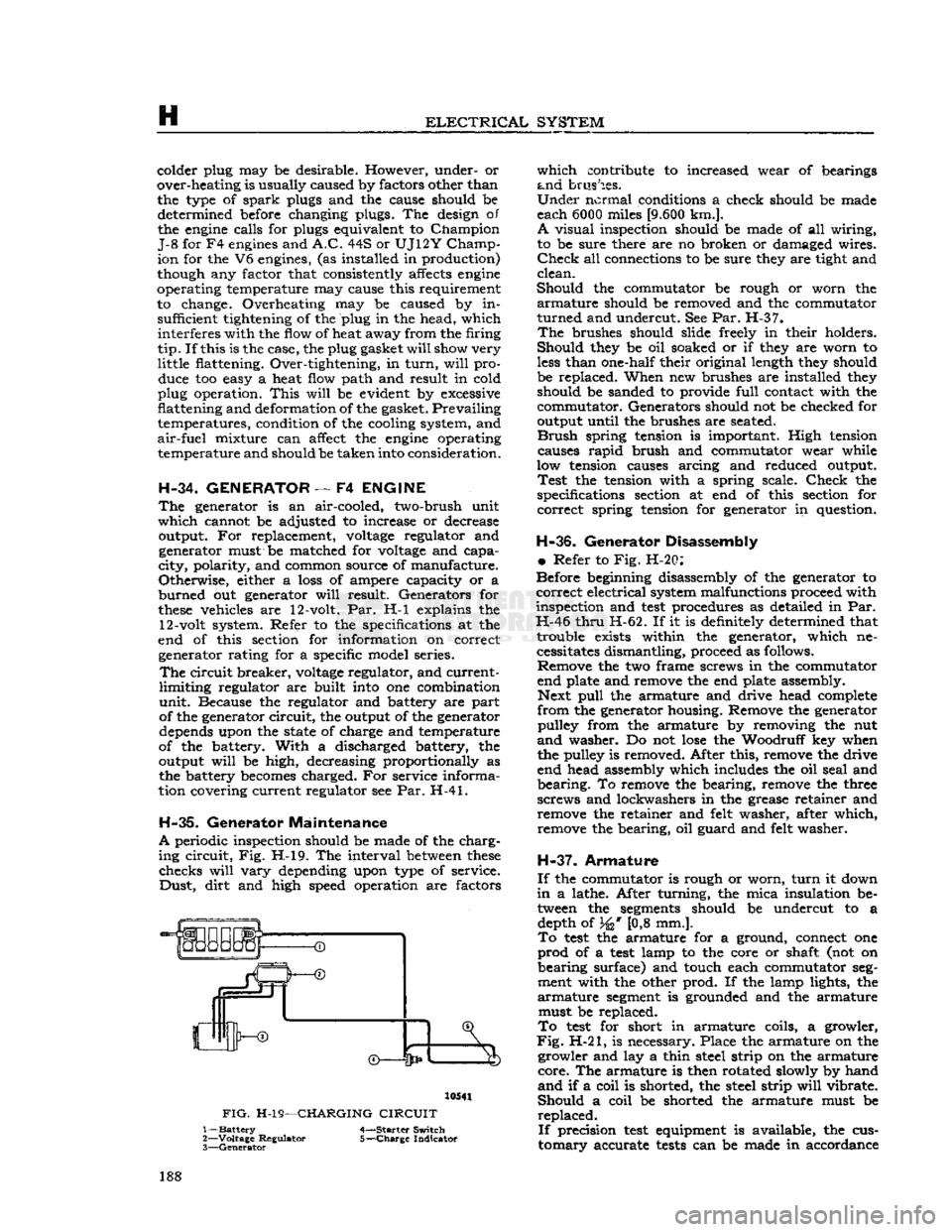
H
ELECTRICAL
SYSTEM
colder plug may be desirable. However, under- or
over-heating is usually caused by factors other than the type of
spark
plugs and the cause should be determined before changing plugs. The design of the
engine
calls for plugs equivalent to Champion
J-8
for F4
engines
and
A.C.
44S or
UJ12Y
Champ
ion for the V6 engines, (as installed in production)
though any factor that consistently affects
engine
operating temperature may cause this requirement
to change. Overheating may be caused by in sufficient tightening of the plug in the head, which interferes with the flow of heat away from the firing
tip.
If this is the case, the plug gasket
will
show very
little flattening. Over-tightening, in
turn,
will
pro duce too easy a heat flow path and result in cold
plug operation.
This
will
be evident by excessive
flattening
and
deformation of the gasket.
Prevailing
temperatures, condition of the cooling system, and
air-fuel
mixture can affect the
engine
operating temperature and should be taken into consideration.
H-34.
GENERATOR
— F4
ENGINE
The
generator is an air-cooled, two-brush unit
which
cannot be adjusted to increase or decrease output. For replacement,
voltage
regulator and generator must be matched for
voltage
and capa
city,
polarity, and common source of manufacture.
Otherwise,
either a
loss
of ampere capacity or a
burned
out generator
will
result. Generators for
these
vehicles are 12-volt. Par. H-l explains the 12-volt system. Refer to the specifications at the
end of this section for information on correct generator rating for a specific model series.
The
circuit
breaker,
voltage
regulator, and current-
limiting
regulator are built into one combination
unit.
Because the regulator and battery are part
of the generator
circuit,
the output of the generator
depends upon the
state
of charge and temperature
of the battery.
With
a discharged battery, the
output
will
be high, decreasing proportionally as the battery
becomes
charged. For service informa
tion covering current regulator see Par. H-41.
H-36.
Generator
Maintenance
A
periodic inspection should be made of the charg
ing
circuit,
Fig. H-l9. The interval
between
these
checks
will
vary
depending upon type of service.
Dust,
dirt
and high speed operation are factors 10541
FIG.
H-19—CHARGING
CIRCUIT
1—
Battery
4-—Starter Switch
2—
Voltage
Regulator 5-—Charge Indicator
3—
Generator
which
contribute to increased wear of bearings
and
brushes.
Under
normal conditions a check should be made
each 6000 miles
[9.600
km.].
A
visual inspection should be made of all wiring,
to be sure there are no broken or damaged wires.
Check
all connections to be sure they are tight and
clean.
Should
the commutator be rough or worn the
armature
should be removed and the commutator
turned
and undercut. See Par. H-37.
The
brushes should slide freely in their holders.
Should
they be oil soaked or if they are worn to
less
than one-half their original length they should
be replaced. When new brushes are installed they should be sanded to provide
full
contact with the
commutator. Generators should not be checked for
output until the brushes are seated.
Brush
spring tension is important. High tension causes
rapid
brush and commutator wear while
low tension causes arcing and reduced output.
Test
the tension with a spring scale.
Check
the
specifications section at end of this section for
correct
spring tension for generator in question.
H-36.
Generator Disassembly
•
Refer to Fig. H-20:
Before beginning disassembly of the generator to
correct
electrical system malfunctions proceed with
inspection and
test
procedures as detailed in Par.
H-46
thru
H-62. If it is definitely determined that trouble exists within the generator, which necessitates dismantling, proceed as follows. Remove the two frame screws in the commutator
end plate and remove the end plate assembly. Next
pull
the armature and drive head complete
from
the generator housing. Remove the generator pulley from the armature by removing the nut
and
washer. Do not
lose
the Woodruff key when
the pulley is removed. After this, remove the drive
end head assembly which includes the oil seal and
bearing.
To remove the bearing, remove the three
screws and lockwashers in the grease retainer and remove the retainer and felt washer, after which,
remove the bearing, oil guard and felt washer.
H-37.
Armature
If
the commutator is rough or worn,
turn
it down
in
a lathe. After turning, the mica insulation be tween the
segments
should be undercut to a depth of 34* [0,8 mm.].
To
test
the armature for a ground, connect one
prod
of a
test
lamp to the core or shaft (not on
bearing
surface) and touch each commutator
seg
ment with the other prod. If the lamp lights, the
armature
segment
is grounded and the armature must be replaced.
To
test
for short in armature coils, a growler,
Fig.
H-21, is necessary. Place the armature on the growler and lay a thin steel strip on the armature
core.
The armature is then rotated slowly by hand
and
if a coil is shorted, the steel strip
will
vibrate.
Should
a coil be shorted the armature must be
replaced.
If
precision
test
equipment is available, the cus
tomary
accurate
tests
can be made in accordance 188
Page 189 of 376
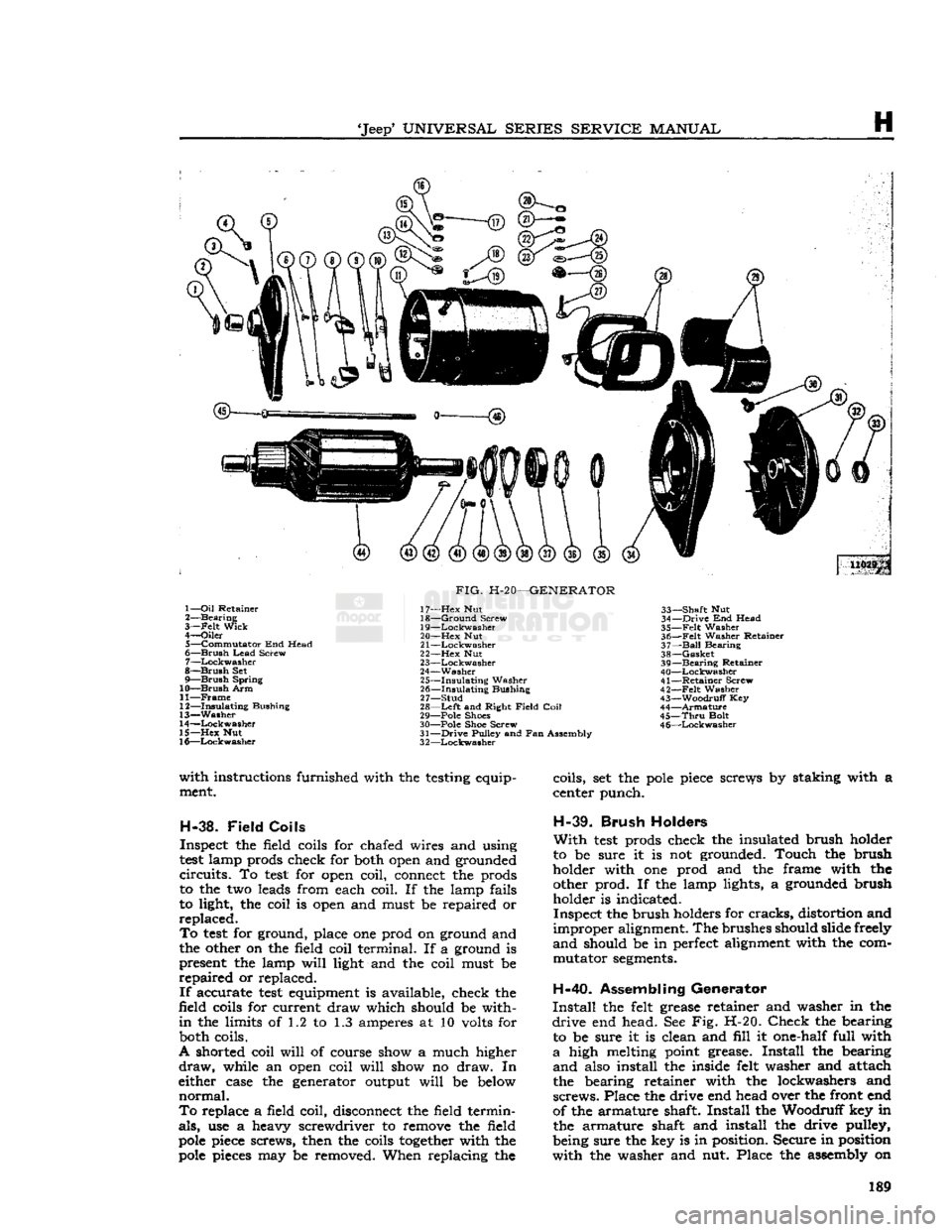
'Jeep'
UNIVERSAL
SERIES
SERVICE
MANUAL
H
U029p 1—
Oil
Retainer
2—
Bearing
3—
-Felt
Wick
4—
Oiler
5—
Commutator
End Head
6—
Brush
Lead
Screw
7—
Lockwasher
8—
Brush
Set
9—
Brush
Spring
10—
Brush
Arm
11—
Frame
12—
Insulating
Bushing
13—
Washer
14—
Lockwasher
15—
Hex
Nut
16—
Lockwasher
FIG.
H-20—GENERATOR
17—
Hex
Nut
18—
Ground
Screw
19—
Lockwasher
20—
Hex
Nut
21
—Lockwasher
22—
Hex
Nut
23—
Lockwasher
24—
Washer
25—
Insulating
Washer
26—
Insulating
Bushing
27—
Stud
28—
Left
and Right
Field
Coil
29— Pole Shoes
30— Pole Shoe Screw
31—
Drive
Pulley and Fan Assembly
3
2—Lockwasher
33—
Shaft
Nut
34—
Drive
End Head
35—
Felt
Washer
36—
Felt
Washer Retainer
37—
Ball
Bearing
38—
Gasket
39—
Bearing
Retainer
40—
Lockwasher
41—
Retainer
Screw
42—
-Felt
Washer
43—
Woodruff
Key
44—
Armature
45—
Thru
Bolt
4
6—Lockwasher
with
instructions furnished with the testing equip ment.
H-38.
Field
Coils
Inspect the field coils for chafed wires and using
test
lamp prods check for both open and grounded
circuits.
To
test
for open coil, connect the prods
to the two leads from each coil. If the lamp fails
to light, the coil is open and must be repaired or
replaced.
To
test
for ground, place one prod on ground and
the other on the field coil terminal. If a ground is present the lamp
will
light and the coil must be
repaired
or replaced.
If
accurate
test
equipment is available, check the
field coils for current draw which should be with
in
the limits of 1.2 to 1.3 amperes at 10 volts for both coils.
A shorted coil
will
of course show a much higher
draw,
while an open coil
will
show no draw. In
either case the generator output
will
be below
normal.
To
replace a field coil, disconnect the field termin
als,
use a heavy screwdriver to remove the field
pole
piece screws, then the coils
together
with the
pole
pieces may be removed. When replacing the coils, set the
pole
piece screws by staking with a
center punch.
H-39.
Brush
Holders
With
test
prods check the insulated brush holder
to be sure it is not grounded. Touch the brush
holder with one prod and the frame with the other prod. If the lamp lights, a grounded brush holder is indicated.
Inspect the brush holders for
cracks,
distortion and
improper
alignment. The brushes should slide freely
and
should be in perfect alignment with the com mutator
segments.
H-40.
Assembling Generator
Install
the felt grease retainer and washer in the
drive
end head. See Fig. H-20.
Check
the bearing to be sure it is clean and
fill
it one-half full with
a
high melting point grease.
Install
the bearing
and
also install the inside felt washer and attach
the bearing retainer with the lockwashers and
screws.
Place the drive end head over the front end
of the armature shaft.
Install
the Woodruff key in the armature shaft and install the drive pulley,
being sure the key is in position. Secure in position
with
the washer and nut. Place the assembly on 189
Page 190 of 376
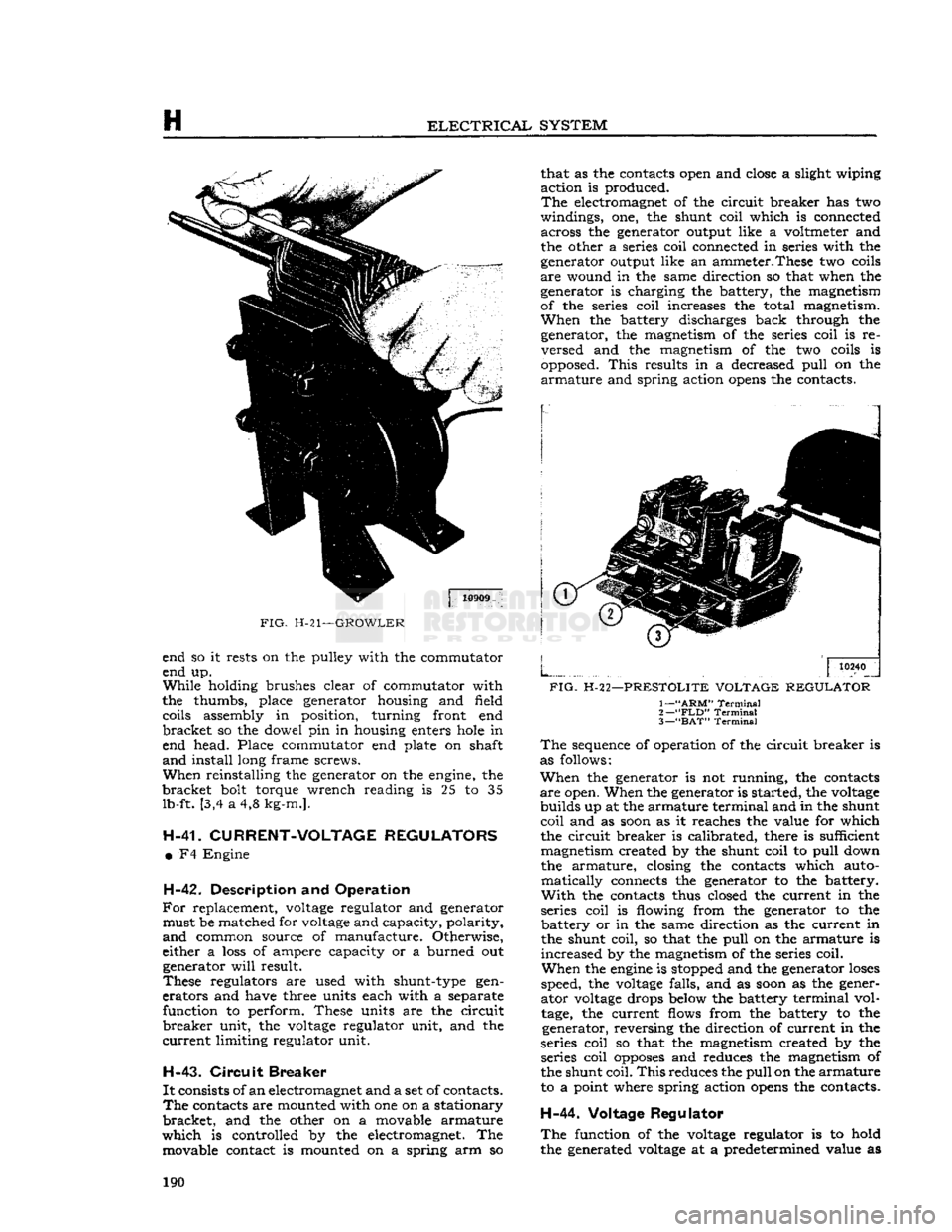
H
ELECTRICAL
SYSTEM
FIG.
H-21—GROWLER
end so it rests on the pulley with the commutator
end up.
While
holding brushes clear of commutator with
the thumbs, place generator housing and field coils assembly in position, turning front end
bracket
so the dowel pin in housing enters
hole
in
end head. Place commutator end plate on shaft
and
install long frame screws.
When
reinstalling the generator on the engine, the
bracket
bolt torque wrench reading is 25 to 35 lb-ft. [3,4 a 4,8 kg-m.].
H-41.
CURRENT-VOLTAGE REGULATORS •
F4 Engine
H-42.
Description and
Operation
For
replacement,
voltage
regulator and generator must be matched for
voltage
and capacity, polarity,
and
common source of manufacture. Otherwise,
either a
loss
of ampere capacity or a burned out generator
will
result.
These
regulators are used with shunt-type gen
erators
and have three units each with a separate function to perform. These units are the circuit
breaker
unit, the
voltage
regulator unit, and the
current
limiting regulator unit.
H-43.
Circuit
Breaker
It
consists of
an
electromagnet and a set of contacts.
The
contacts are mounted with one on a stationary
bracket,
and the other on a movable armature
which
is controlled by the electromagnet. The movable contact is mounted on a spring arm so that as the contacts open and
close
a slight wiping
action is produced.
The
electromagnet of the circuit breaker has two
windings, one, the shunt coil which is connected across the generator output like a voltmeter and
the other a series coil connected in series with the
generator output like an ammeter.These two coils
are
wound in the same direction so that when the
generator is charging the battery, the magnetism
of the series coil increases the total magnetism.
When
the battery discharges back through the generator, the magnetism of the series coil is re versed and the magnetism of the two coils is
opposed.
This
results in a decreased
pull
on the
armature
and spring action
opens
the contacts.
10240
FIG.
H-22—PRESTOLITE VOLTAGE REGULATOR
1—
"ARM"
Terminal
2—
"FLD"
Terminal
3— "BAT"
Terminal
The
sequence of operation of the circuit breaker is
as follows:
When
the generator is not running, the contacts
are
open. When the generator is started, the
voltage
builds up at the armature terminal and in the shunt
coil
and as
soon
as it reaches the value for which
the circuit breaker is calibrated, there is sufficient magnetism created by the shunt coil to
pull
down
the armature, closing the contacts which auto
matically
connects the generator to the battery.
With
the contacts thus closed the current in the
series coil is flowing from the generator to the battery or in the same direction as the current in
the shunt coil, so that the
pull
on the armature is
increased
by the magnetism of the series coil.
When
the
engine
is stopped and the generator
loses
speed, the
voltage
falls, and as
soon
as the gener
ator
voltage
drops below the battery terminal vol
tage,
the current flows from the battery to the generator, reversing the direction of current in the
series coil so that the magnetism created by the series coil
opposes
and reduces the magnetism of
the shunt
coil.
This
reduces the
pull
on the
armature
to a point where spring action
opens
the contacts.
H-44.
Voltage
Regulator
The
function of the
voltage
regulator is to hold
the generated
voltage
at a predetermined value as 190